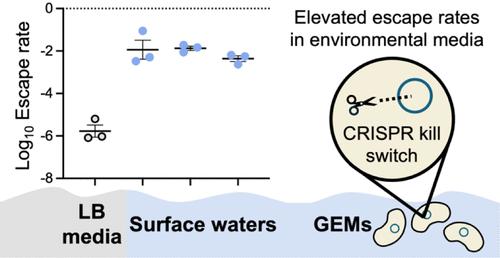Influence of Environmental Conditions on the Escape Rates of Biocontained Genetically Engineered Microbes
IF 11.3
1区 环境科学与生态学
Q1 ENGINEERING, ENVIRONMENTAL
引用次数: 0
Abstract
The development of genetically engineered microbes (GEMs) has resulted in an urgent need to control their persistence in the environment. The use of biocontainment such as kill switches is a critical approach to prevent the unintended proliferation of GEMs; however, the effectiveness of kill switches─reported as escape rates, i.e., the ratio of the number of viable microbes when the kill switch is triggered relative to the number when it is not triggered─is typically assessed under laboratory conditions that do not resemble environmental conditions under which biocontainment must perform. In this study, we discovered that the escape rate of an Escherichia coli GEM biocontained with a CRISPR-based kill switch triggered by anhydrotetracycline (aTc) increased by 3–4 orders of magnitude when deployed in natural surface waters as compared to rich laboratory media. We identified that environmental conditions (e.g., pH, nutrient levels) may contribute to elevated escape rates in multiple ways, including by altering the chemical speciation of the kill switch trigger to reduce its uptake and providing limited nutrients required for the kill switch to function. Our study demonstrated that conditions in the intended environment must be considered in order to design effective GEM biocontainment strategies.

环境条件对含生物基因工程微生物逃逸率的影响
基因工程微生物(GEMs)的发展导致迫切需要控制其在环境中的持久性。使用诸如杀伤开关之类的生物防护措施是防止GEMs意外扩散的关键办法;然而,关闭开关的有效性──报告为逃逸率,即关闭开关触发时活菌数量与未触发时的活菌数量之比──通常是在实验室条件下评估的,而实验室条件与必须实施生物控制的环境条件并不相似。在这项研究中,我们发现,与丰富的实验室培养基相比,在自然地表水中部署时,含有由无水四环素(aTc)触发的基于crispr的杀伤开关的大肠杆菌GEM生物逃逸率增加了3-4个数量级。我们发现,环境条件(如pH值、营养水平)可能以多种方式导致逃逸率升高,包括改变“死亡开关”触发物的化学形态,以减少其吸收,并提供“死亡开关”发挥作用所需的有限营养。我们的研究表明,为了设计有效的GEM生物防护策略,必须考虑预期环境中的条件。
本文章由计算机程序翻译,如有差异,请以英文原文为准。
求助全文
约1分钟内获得全文
求助全文
来源期刊

环境科学与技术
环境科学-工程:环境
CiteScore
17.50
自引率
9.60%
发文量
12359
审稿时长
2.8 months
期刊介绍:
Environmental Science & Technology (ES&T) is a co-sponsored academic and technical magazine by the Hubei Provincial Environmental Protection Bureau and the Hubei Provincial Academy of Environmental Sciences.
Environmental Science & Technology (ES&T) holds the status of Chinese core journals, scientific papers source journals of China, Chinese Science Citation Database source journals, and Chinese Academic Journal Comprehensive Evaluation Database source journals. This publication focuses on the academic field of environmental protection, featuring articles related to environmental protection and technical advancements.
 求助内容:
求助内容: 应助结果提醒方式:
应助结果提醒方式:


